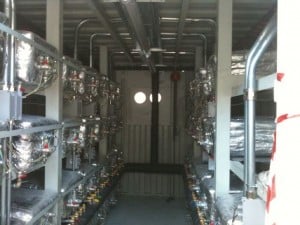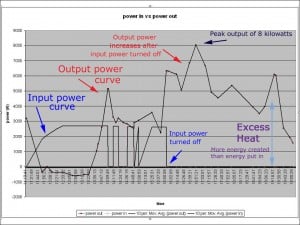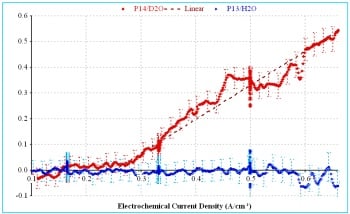Our greatest blessings come by way of madness, indeed of a madness that is heaven-sent.
–‘Socrates’ on the Oracle of Delphi in Phaedo
A test of the first commercial cold fusion technology held on October 6 at the University of Bologna, Italy continues to draw debate on just how much excess heat was generated.
Excess heat is the condition of more heat energy created than equivalent energy put in a device and is the sought-after effect in cold fusion research for its potential to generate ultra-clean power to replace dirty fossil and dangerous radioactive fuels.

Preliminary data revealed that excess heat was produced; though just how much will remain unknown until reports from the various scientists in attendance are released.
An early tweet from Robert Zreick and subsequent report by NYTeknik science journalist Mats Lewan showed a lower limit of excess heat between 2-3 kilowatts. This value is a lower limit as a small amount of hot water and steam were removed from the system without measurement. Had that heated mass of water and steam been measured and the energy added to the system, the total excess heat measured would be higher.
In this particular demonstration, a heat exchanger cooled and condensed the steam emitted from the E-Cat transferring the heat to a secondary flow of water. The change in temperature of that secondary flow of water gives one measure of the energy provided by the E-Cat.
This video posted by ecatdotcom channel has an overview of the test.
Using the data provided by Mats Lewan, this graph generated by Eric Hustedt (see below; my addition includes the arrows and text.) Both the input energy curve and the output energy curves are plotted together. Input power is in the form of electrical power and used to start the reaction between the fuel of hydrogen and its nickel powder environment. Output power was measured by the difference in temperatures of the water in a secondary loop of heated water.
At first, it appears the input power is turned on and off a few times. The output power drops during this initial (loading?) period, then begins to rise rapidly, settling on a bumpy plateau. After about four hours, around mark 15:37, the output power appears to increase rapidly again, rising almost vertically to over 6 kilowatts. The input power is then turned off to zero.

After the input power is turned off, notice the output power eventually reaches a maximum of 8 kilowatts. After a short decline, there are two more instances of increased output power, with a final decline after which the demonstration is ended.
The total area underneath the power output curve appears greater than the total area underneath the input power curve. Therefore, we conclude that excess heat was generated. However, the up-and-down nature of the power generated may show possible instability. Until reports from scientists who attended the demonstration are released, these musings are merely speculations.
One of the best features of cold fusion research is that there are many such systems that generate excess heat, not just nickel and hydrogen.

Notice the blue line of the output power is above the red graph of the input power. The difference in height of the two curves represents the excess heat energy generated; the Phusor cell is producing more energy than it is consuming.
The LENR-CANR Library contains thousands of papers from scientists worldwide investigating the properties of multiple types of similar energy-producing systems. Editor Jed Rothwell has a graph from Dr. Michael McKubre‘s lab at SRI International on the homepage.
Both Dr. Swartz and Dr. McKubre are just two cold fusion researchers who have repeatedly witnessed the creation of large amounts of energy in small, tabletop ‘cells’ that use a fuel of hydrogen and/or its isotopes, and various transition metals as host to the reaction. There are many other labs, and many other scientists on the verge of unlocking the power of these systems. The enigmatic theory behind the effect may elude researchers, but the results are empirical and undeniable despite mainstream science’s refusal to acknowledge this field.
Mr. Rossi is the first to bring this science into the realm of a usable technology. Yet, even among the cold fusion community, ostracized as it is from conventional scientific circles, Mr. Rossi is an outsider, criticized for lacking discipline and method. Tensions are elevated as the emotional investment over two decades, with a corresponding lack of financial support, has reached the limit of tolerability, and the need for this technology is so great.

You don’t like those ideas? I got others.
–Marshall McLuhan
The fact is there is no map outlining the process of rolling out a revolutionary breakthrough technology. The personal computer was dispersed into the population under the noses of Mainframe, Inc. by two young guys with their parents in the next room. The New Fire is emerging from a just-as-unconventional lone inventor who plays jazz drums and knows a good samba when he hears it.

Yes, this engineer of The New Fire demonstrates the energy of humanity’s future using a carburetor-sized heat exchanger, bathroom scales, and duc tape. A perfect scientific method performed on ideal spheres has encountered the spontaneity of jazz drums and electric tweets in a science fiction environment of artificial intelligence so pervasive it goes unnoticed. Science is being done in a world-wide lab where all times are happening at once.
Marrying high and low technologies from various ages has a name – Steampunk. The Steampunk artist rides the collision of centuries and translates that reality into objects that fuse hand-made efforts with factory-made design and modern electronics.

Steam Punk Andrea Rossi has brought world attention to a new energy technology that is in its first stages of actuality and which draws on the simple elements of hydrogen from water and a metal powder that combine to create a powerful energy that defies conventional theories of “modern” physics promising clean, abundant energy for the whole world.
Whether the device demonstrated on October 6 generated power of X kilowatts or Y kilowatts pales to the fact that we have a new energy technology – confirmed by science – that needs support for development, and promptly.
It is our best chance for a technological future on Earth.
Cold Fusion Now!
Related Links
What is Steampunk? http://www.steampunk.com/what-is-steampunk/
New test of the E-cat enhances proof of heat by Mats Lewan from NYTeknik
E-Cat October 6 Test: Questions on the Day After by Raymond Zreik from Focus.it
22 Passi d’amore e dintorni Daniele Passerini from http://22passi.blogspot.com/
Leonardo Corporation homepage
Jet Energy, Inc homepage
LENR-CANR Library homepage

http://www.youtube.com/watch?v=dlzrNKN3rZI
PS
Forget the “mainstream” news.
We have Ruby.
Great post Ruby!
Ruby,
This is a great post!
Mark
Perfect blog with interesting design!
Thanks kote and Mark. And Happy Birthday, Birthday Boy.
Ruby it would seem very little has changed from Galileo’s day, just a change in the players.
and closed minded religion is replaced with closed minded science.
george, it’s a rearview mirror world.
It would be nice to see something come of this.
I won’t be doing any victory dances myself until the inventor and his crew learn how to properly conduct a test that provides valid measurements of all inputs and outputs to the system.
Everything published so far has only provided incomplete or outright dubious data.
Again, I want to see something like this work unequivocally and without a bunch of hand waving and mountebank behavior on the part of the inventor and his crew.
If wishing made it so!
I wish this research had been funded 22 years ago, and we could be living in a clean energy world right now! If only we could manufacture some imagination in people’s minds.
Whatever the details of the data, this energy effect is real, and it’s only a matter of time before it’s developed just right. Too many know of this now.
We will have this energy, or we will have no good future.
“Steampunk retrieves the early industrial efforts before fossil fuels, painting the Josephson junctions and digital chips with a veneer of human scale.”
I’m very much in favor of human scale, but I’d like to point out that coal is a fossil fuel and it was coal that powered the first commercial steam engines in the 18th century which led to the 19th century Industrial Revolution. I’d always thought that Steampunk was reviving a late-Victorian (H.G. Wells, Jules Verne) sort of aesthetic, but that’s at least 100 years after the industrial revolution began. If it were referencing the era “before fossil fuels”, wouldn’t that mean everyone would be wearing powdered wigs and buckles on their shoes? Perhaps I am misunderstanding something.
Anyway, this new “cold-fusion” tech – if it turns out to be viable – could actually lead to the new steam age since that’s certainly what it seems to produce a lot of.